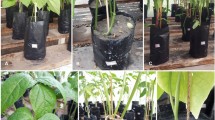Abstract
Fusariumsambucinum(F. trichothecioides),F. avenaceum andF. crookwellense, were the species most frequently isolated from lots of potato tubers imported to Southern Italy in 1985. Isolates of these species were tested for the production of zearalenone, zearalenols, trichothecenes and moniliformin, on three solid media (autoclaved kernels of maize or rice, and fresh potato tubers), incubated at different conditions. The toxigenic potential of the isolates was expressed only on rice and maize, while they were non capable to produce toxins on fresh potato under any conditions. In particular,F. crookwellense produced zearalenone and/or zearalenols (diastereomeric mixture) on maize, andF. avenaceum produced moniliformin both on maize and on rice; while no toxins were produced byF. sambucinum.
Similar content being viewed by others
References
Rich AE (1983) Potato diseases. Academic Press Inc London, 238 p.
Boyd AEW (1972). Potato storage diseases. Rev Plant Pathol 51:297–321.
Steyn PS, Vleggaar R, Rabie CJ, Kriek NPJ, Harington JS (1978) Trichothecene mycotoxins fromFusarium sulphureum. Phytochemistry 17:949–951.
El-Banna AA, Scott PM, Lau P, Sakuma T, Platt HW, Campbell V (1984) Formation of trichothecenes byFusarium solani var.coeruleum andFusarium sambucinum in potatoes. Appl Environ Microbiol 47:1169–1171.
Nash SM, Snyder WC (1965) Quantitative estimations by plate counts of propagules of the bean root rotFusarium in field soil. Phytopathology 52:567–572.
Nelson PE, Toussoun TA, Marasas WFO (1983) Fusarium species: an illustrated manual for identification. The Pennsylvania State Univ Press, University Park, 193 p.
Booth C (1971) The genusFusarium. Commonw Mycol Inst, Kew, England, 237 p.
Visconti A, Bottalico A (1983) Detection ofFusarium trichothecenes (nivalenol, deoxynivalenol, fusarenone and 3-acetyldeoxynivalenol) by high performance liquid chromatography. Chromatography 17:97–100.
Bottalico A, Visconti A, Logrieco A, Solfrizzo M, Mirocha CJ (1985) Zearalenols (diastereomeric mixture) occurence in corn stalk rot and their production by associatedFusarium species. Appl Environ Microbiol 49:547–551.
Author information
Authors and Affiliations
Rights and permissions
About this article
Cite this article
Logrieco, A., Bottalico, A. & Solfrizzo, M. ToxigenicFusarium species isolated from rotted potato tubers. Mycotox Res 3 (Suppl 1), 105–110 (1987). https://doi.org/10.1007/BF03192040
Issue Date:
DOI: https://doi.org/10.1007/BF03192040



